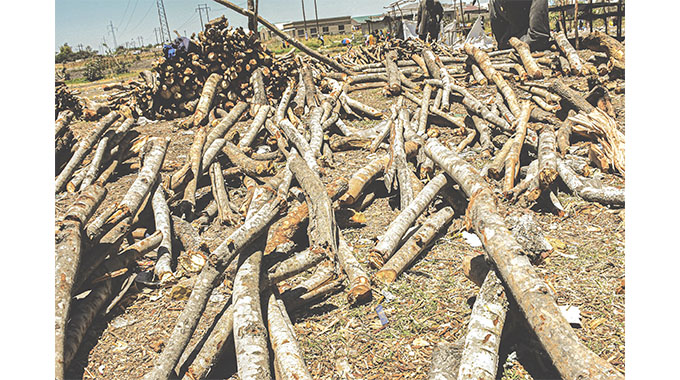Firewood and charcoal — environmental and socio-economic impacts

Fortunes Matutu
FIREWOOD consumption and charcoal production are some of the leading drivers of deforestation in Zimbabwe. Over 96 percent of rural households depend on firewood for all their cooking and other energy requirements like tobacco curing and brick moulding.
There is also increasing popularity of charcoal use among urban households as a result of rapid urbanisation and insufficient supply of alternative fuels at prices which consumers can easily afford. This is emanating from increased demand for fuel wood in response to unreliable power supply and new suburbs which are not connected to the electricity grid. As a result, wood-based energy, firewood and charcoal have become a suitable substitute because it is largely considered cheap and abundant.
Firewood and charcoal stalls are now common in urban areas and highways. Research has shown that over 25 percent of urban households use firewood as their primary source of energy for cooking while 70 percent use it as a substitute to electricity due to increased load shedding and high electricity costs.
Consequently, the demand for wood energy in urban areas has caused serious deforestation in urban areas, peri-urban areas and now even areas seemingly distant from the cities where trees are still considered to be infinitely in abundance. The adverse impacts of this are already clear but will increase if the trend remains. These impacts include land degradation, soil erosion, loss of browse for livestock, loss of fruits (affecting food security), loss of non-timber forest products and climate change.
While charcoal production and sale are illegal in Zimbabwe, the benefits for urban consumers are clear; its low cost and high energy per unit weight makes it lucrative for traders. However, the practice of producing charcoal has to be curbed before it decimates forests in the country.
The law permits use of firewood for domestic purposes at source only. It is the transportation and commercialisation of wood energy that is of concern because it causes deforestation. Of particular concern now in Zimbabwe is increased illegal large-scale charcoal production due to its destructive nature to the environment, devastating threat of deforestation, land degradation and climate change.
While it may look like a lucrative industry for some people, the economic benefits for a few individuals have far reaching consequences on the environment, structure and functioning of ecosystems as well as social economics.
The current price of charcoal ranges between US$5 to US$10 for a 50kg bag. This price in principle doesn’t include the cost of raw materials (trees, grass and soil) because they are simply obtained and not paid for. When the cost of labour, raw materials and opportunity costs are considered, the net present value (NPV) of charcoal in on average negative (US$1 200 per ha). This means that the profit is gained at the expense of other potential uses and services from the trees and woodlands. The presumed profit is attributable to very low capital expenses, “free” raw materials — wood, soil and grasses and lack of concern about associated external costs.
The process of charcoal production is wasteful, labour intensive and harmful to health. Current methods of charcoal production require vast amounts of resources for relatively little return. It is commonly made in traditional earth and pit kilns (ovens) with a wood-to-charcoal conversion rate of about 20 percent, meaning that for example 5 tonnes of firewood are needed to produce 1 tonne of charcoal.
Unregulated actions of charcoal producers cause huge volumes of wet wood from trees to be poached. These areas are often grazing areas of communal areas, farms and protected forests.
The wood is stacked compactly in a pit or in the ground. The stack is covered with grass and then buried under a layer of soil to form the “oven” or kiln. This kiln is then ignited with burning embers introduced at one or more points at the bottom of the stack, allowing carbonation under limited air. When the kiln has been lit, it requires continuous attention for five to 14 days depending on the size.
Extreme temperatures combined with volatile chemical compounds, including carbon monoxide and sulphur dioxide, create an extremely dangerous environment for any human being, especially those without adequate safety protection. Producers are often known to spend all day and night within a few metres of a burning kiln to ensure that any gaps are quickly sealed. Thus, charcoal production is dangerous to human health and also contributes to climate change through release of green house gases and removal of the carbon sink.
While charcoal traders argue that they have no option but to engage in the lucrative business it remains illegal. Their valued argument is based on poverty and means to earn a living. People use forest resources as safety nets because of the difficult situations like lack of employment and failing agriculture. However, trees still have to be conserved because if they are not, it will create a host of other problems which have great effect on the livelihoods of people and biodiversity.
The loss of trees and other vegetation leads to desertification, soil erosion, land degradation, reduced agriculture outputs, increased natural disasters and increased greenhouse gases in the atmosphere which cause climate change. Communities also rely on forest resources for a range of livelihood activities such as provision of essential nutrition, raw material and medicines which cannot be substituted in the absence of trees.
Deforestation destroys essential ecosystem services which are important in the rural agriculture-based economies like the provision of clean water and fertile soils, leading to the loss of farming and other livelihood opportunities.
Furthermore, deforestation is detrimental to the eco-tourism industry as it causes loss of biodiversity.
Therefore, considering the overall effect of increased use of wood energy there is a need to balance environmental sustainability and livelihoods. This needs multi-stakeholders to come together and find solutions like alternative livelihoods and the provision of cheaper energy in urban areas.
The outcomes of the multi-stakeholder engagements at the end of it all need to demonstrate coherence with globally recognised principles, goals and relevant international regimes, such environmental rights and sustainable development goals. In this way forests can significantly contribute to livelihoods, poverty reduction and environmental sustainability for future generations.
-Fortunes Matutu is a forester with the Forestry Commission and has a special interest in social forestry.











Comments